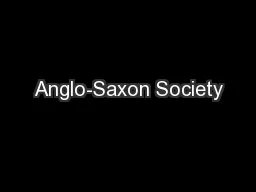

1042 The AngloSaxon age in Britain was from around AD410 to 1066 They were a mix of tribes from Germany Denmark and the Netherlands The three biggest were the Angles the Saxons and the Jutes ID: 613687
Download Presentation The PPT/PDF document "Anglo-Saxon Society" is the property of its rightful owner. Permission is granted to download and print the materials on this web site for personal, non-commercial use only, and to display it on your personal computer provided you do not modify the materials and that you retain all copyright notices contained in the materials. By downloading content from our website, you accept the terms of this agreement.
Slide1
Anglo-Saxon SocietySlide2
1042Slide3
The Anglo-Saxon age in Britain was from around AD410 to 1066.
They were a mix of tribes from Germany, Denmark and the Netherlands. The three biggest were the Angles, the Saxons and the Jutes.
The land they settled in was 'Angle-land', or England.Slide4
Population of England was roughly 1 million people, the majority of which were
peasant
farmers.
They worked on land given to them by the local lord.
They were ‘tied’ to the land – if they did not work hard they could lose the right to use the land.
Ceorls
were free peasants, who were free to go and work for other lords if they wanted to.Slide5
CHILDREN - Did not go to school, were expected to work and provide around farm.They looked after animals and would collect firewood from nearby forests.Free time: carved wooden toys and played board games.Considered an adult at 10
WOMEN - S
pun wool from sheep and goats to make thread, which would woven into cloth.
Cooked food for families (mostly boiled in a cauldron over fire). Made ale, cheese etc.
MEN -
h
unt for food (ducks, pigeons, boar, wolves)
Plant crops like wheat, oats and barley.
Raise animals like pigs , cows and sheep for food.Slide6Slide7Slide8
The
human population was very small. There were perhaps one million people in England at that time.
Almost
all of them lived in tiny villages - many had less than 100 inhabitants.
10% of the population lived in towns.
(London only had a population of 18,000!!)
Each
village was mainly self sufficient. The people needed only a few things from outside like salt and iron. They grew their own food and made their own clothes
.
https://www.youtube.com/watch?v=EZk0K0CXboE
Slide9Slide10Slide11Slide12Slide13
In the early Anglo-Saxon period, England was actually 7 separate Kingdoms.
By the reign of Edward the Confessor, it was one single Kingdom divided into separate Earldoms.
Each earldom was ruled by an Earl who pledged allegiance to the king in return for land and power.
The largest were Northumbria, Mercia, Wessex and East Anglia.Slide14
King
Earls
Thegns
Peasant Farmers
Slaves
King created earls and demanded loyalty and military support
Earls ruled an area on King’s behalf. Could challenge king to gain more power.
Thegns
held land for Earl and fought in their armies for the King.
Thegns
rented out land to peasant farmers.
Peasants could become
Thegns
if they saved.
Thegns
could be raised to the title of Earl
Peasants could sell themselves into slavery.
Slaves could be freed by their mastersSlide15
Got it!Create a chart to show the status and role of Earls, Thegns
, Peasant Farmers and Slaves
Create a diagram to show the key roles of men, women and children in Anglo-Saxon England.
Expert!
Describe two key features of the social system of Anglo-Saxon England. (4 marks)
Describe two key features of life in Anglo-Saxon England.
Show off!
Create a Venn diagram showing the similarities and differences Anglo-Saxon society and modern day society.